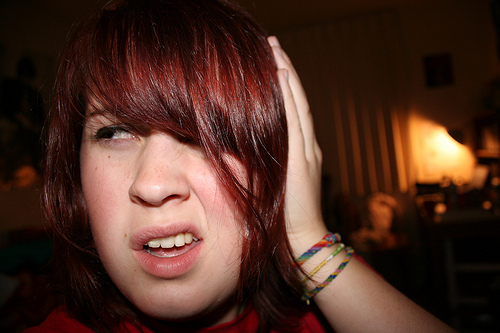Misophonia, literally hatred of sound, is a term that was introduced in 2001 by American scientists Pawel J. and Margaret M. Jastreboff to describe abnormally strong negative reactions to everyday sounds that range from chewing and throat clearing, to lip smacking, pen clicking, and cell phone texting.
“I keep a list of friends that I know I can’t sit next to when out for dinner,” said Alessia Di Cesare, a psychology graduate at Concordia University, who can’t stand the sound of people chewing with their mouth open.
Di Cesare believes she has a mild form of the little-known disorder.
According to Drs. Jastreboff, patients commonly report certain triggering factors related to misophonia and hyperacusis (an over-sensitivity to sound that is perceived as abnormally loud or physically painful). These triggers include chronic exposure to sound and impulse noise (abrupt, unwanted and often loud sounds like gunshots or fireworks); head injury and/or surgery; stress associated with an event such as a dental procedure; or sounds associated with new surroundings such as college cafeterias and new living spaces.
People with misophonia experience a range of negative reactions to sound.
“I find myself feeling anxious, irritable, aggressive and angry,” said Di Cesare.
The type of reaction depends on non-auditory factors, such as the persons’ previous attitudes towards the sound in question, their psychological profile, and the context in which the sound is presented.
Audiologist Marsha Johnson believes the condition tends to appear in the early teens and worsens with time. For Di Cesare, the symptoms began two years ago and have since worsened.
“When I hear people chewing with their mouth open, I walk away,” said Di Cesare.
In an interview published by the New York Times, Dr. Johnson stated that because the condition remains poorly studied and understood, people with misophonia are often diagnosed as sufferers of phobic and obsessive-compulsive disorders, or as being bipolar, manic, and anxious.
Diagnosis of misophonia is complex and involves an audiological test measuring what is known as the loudness discomfort level of the individual and a specific, detailed interview with the patient. In practice, hyperacusis and misophonia frequently occur together. In patients with significant hyperacusis, misophonia is automatically created because the discomfort of normal sounds automatically elicits negative reactions.
Aage R. Moller, a neuroscientist at the University of Texas at Dallas who specializes in the auditory nervous system, stated in the medical guidebook Textbook of Tinnitus that there is no known effective treatment for the condition. Dr. Moller believes the condition is probably not an auditory disorder but a “physiological abnormality” within the brain.
Because of the lack of treatment, Di Cesare has made lifestyle changes to keep her symptoms in check.
“Dinner with my family was a challenge until I made having the radio on a rule at the table…anything to muffle the sound of chewing,” she said.
The lack of research on the disorder has left many sufferers of misophonia turning to online forums and blogs to look for support. In the hope of sparking interest, Dr. Johnson has set-up a group called Selective Sound Sensitivity that provides support, information, and awareness about misophonia.
